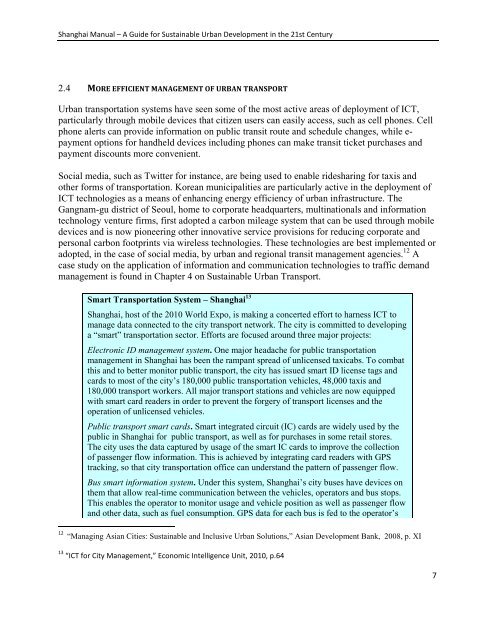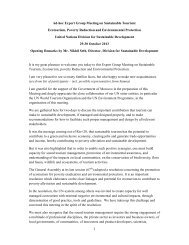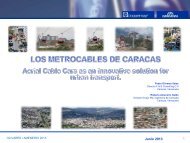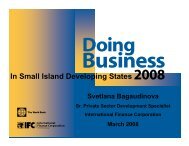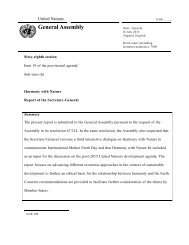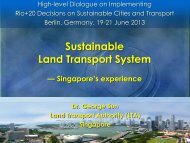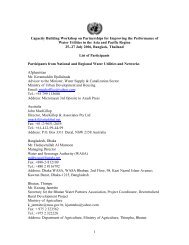A Guide for Sustainable Urban Development of the 21st Century
A Guide for Sustainable Urban Development of the 21st Century
A Guide for Sustainable Urban Development of the 21st Century
You also want an ePaper? Increase the reach of your titles
YUMPU automatically turns print PDFs into web optimized ePapers that Google loves.
Shanghai Manual – A <strong>Guide</strong> <strong>for</strong> <strong>Sustainable</strong> <strong>Urban</strong> <strong>Development</strong> in <strong>the</strong> <strong>21st</strong> <strong>Century</strong>2.4 MORE EFFICIENT MANAGEMENT OF URBAN TRANSPORT<strong>Urban</strong> transportation systems have seen some <strong>of</strong> <strong>the</strong> most active areas <strong>of</strong> deployment <strong>of</strong> ICT,particularly through mobile devices that citizen users can easily access, such as cell phones. Cellphone alerts can provide in<strong>for</strong>mation on public transit route and schedule changes, while e-payment options <strong>for</strong> handheld devices including phones can make transit ticket purchases andpayment discounts more convenient.Social media, such as Twitter <strong>for</strong> instance, are being used to enable ridesharing <strong>for</strong> taxis ando<strong>the</strong>r <strong>for</strong>ms <strong>of</strong> transportation. Korean municipalities are particularly active in <strong>the</strong> deployment <strong>of</strong>ICT technologies as a means <strong>of</strong> enhancing energy efficiency <strong>of</strong> urban infrastructure. TheGangnam-gu district <strong>of</strong> Seoul, home to corporate headquarters, multinationals and in<strong>for</strong>mationtechnology venture firms, first adopted a carbon mileage system that can be used through mobiledevices and is now pioneering o<strong>the</strong>r innovative service provisions <strong>for</strong> reducing corporate andpersonal carbon footprints via wireless technologies. These technologies are best implemented oradopted, in <strong>the</strong> case <strong>of</strong> social media, by urban and regional transit management agencies. 12 Acase study on <strong>the</strong> application <strong>of</strong> in<strong>for</strong>mation and communication technologies to traffic demandmanagement is found in Chapter 4 on <strong>Sustainable</strong> <strong>Urban</strong> Transport.Smart Transportation System – Shanghai 13Shanghai, host <strong>of</strong> <strong>the</strong> 2010 World Expo, is making a concerted ef<strong>for</strong>t to harness ICT tomanage data connected to <strong>the</strong> city transport network. The city is committed to developinga “smart” transportation sector. Ef<strong>for</strong>ts are focused around three major projects:Electronic ID management system. One major headache <strong>for</strong> public transportationmanagement in Shanghai has been <strong>the</strong> rampant spread <strong>of</strong> unlicensed taxicabs. To combatthis and to better monitor public transport, <strong>the</strong> city has issued smart ID license tags andcards to most <strong>of</strong> <strong>the</strong> city’s 180,000 public transportation vehicles, 48,000 taxis and180,000 transport workers. All major transport stations and vehicles are now equippedwith smart card readers in order to prevent <strong>the</strong> <strong>for</strong>gery <strong>of</strong> transport licenses and <strong>the</strong>operation <strong>of</strong> unlicensed vehicles.Public transport smart cards. Smart integrated circuit (IC) cards are widely used by <strong>the</strong>public in Shanghai <strong>for</strong> public transport, as well as <strong>for</strong> purchases in some retail stores.The city uses <strong>the</strong> data captured by usage <strong>of</strong> <strong>the</strong> smart IC cards to improve <strong>the</strong> collection<strong>of</strong> passenger flow in<strong>for</strong>mation. This is achieved by integrating card readers with GPStracking, so that city transportation <strong>of</strong>fice can understand <strong>the</strong> pattern <strong>of</strong> passenger flow.Bus smart in<strong>for</strong>mation system. Under this system, Shanghai’s city buses have devices on<strong>the</strong>m that allow real-time communication between <strong>the</strong> vehicles, operators and bus stops.This enables <strong>the</strong> operator to monitor usage and vehicle position as well as passenger flowand o<strong>the</strong>r data, such as fuel consumption. GPS data <strong>for</strong> each bus is fed to <strong>the</strong> operator’s12 “Managing Asian Cities: <strong>Sustainable</strong> and Inclusive <strong>Urban</strong> Solutions,” Asian <strong>Development</strong> Bank, 2008, p. XI13 “ICT <strong>for</strong> City Management,” Economic Intelligence Unit, 2010, p.647


